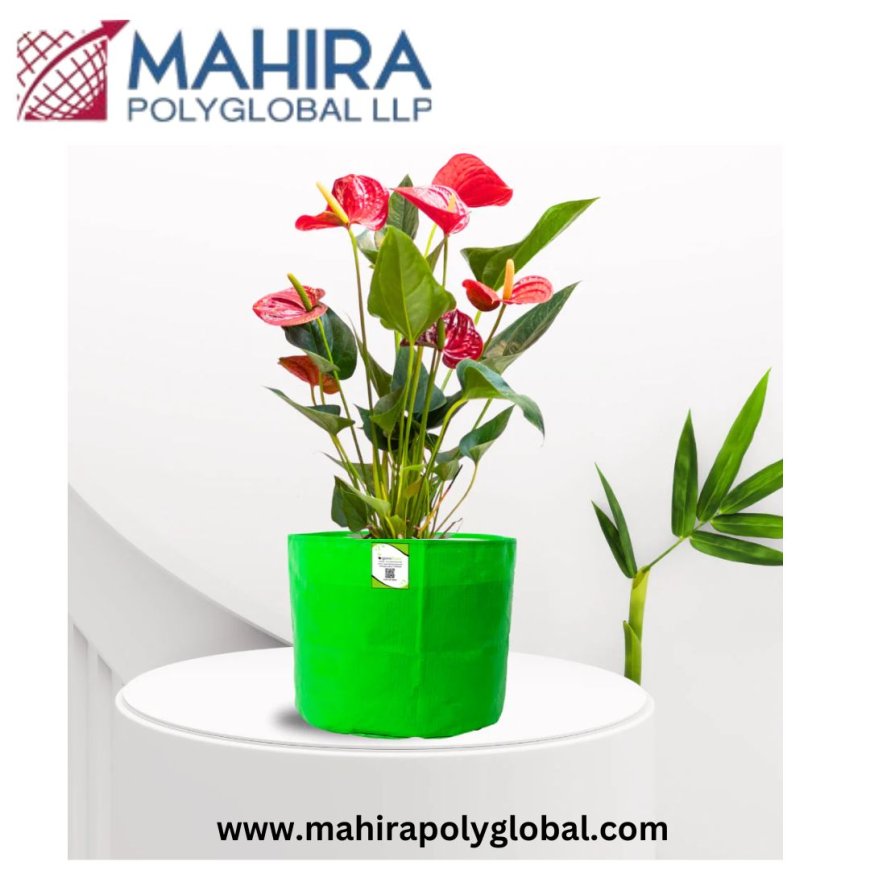Planter Bags: A Modern Solution for Gardening

Gardening enthusiasts and agricultural professionals alike have long sought efficient, practical, and eco-friendly methods to cultivate their plants. One modern solution gaining rapid popularity is the use of planter bags. These flexible, portable, and breathable containers have revolutionized the way we think about growing plants, making gardening more accessible to everyone, whether on a balcony, terrace, or expansive farm. In this Mahira Polyglobal LLP, we explore the numerous benefits of planter bags, key factors to consider when choosing them, and frequently asked questions to help you make informed decisions.
1. What are Planter Bags?
Planter bags, also known as plant grow bags or plant growing bags, are flexible containers made from a variety of materials, most commonly breathable fabric. They allow for improved root aeration and drainage, which is essential for promoting healthy plant growth. Unlike traditional pots, planter bags encourage plants to "air-prune" their roots, which prevents them from becoming root-bound, a common issue in rigid containers. This air-pruning process stimulates the development of more fibrous roots, increasing the plant’s ability to absorb water and nutrients, thereby promoting healthier growth.
With different sizes available, ranging from small 1-gallon bags to large 200-gallon bags, these innovative containers can be used to grow anything from small herbs to large shrubs and trees. Whether you are an urban gardener or manage a commercial farm, planter bags offer a flexible and effective solution for a variety of gardening needs.
2. Why Choose Planter Bags Over Traditional Pots?
When comparing planter bags to traditional pots, the advantages become evident. For one, the portability and flexibility of grow bags make them a superior choice for gardeners who wish to move their plants around to capture optimal sunlight or adjust to seasonal changes. Additionally, the fabric material used in planter bags allows for better breathability, which is crucial for healthy root development. Traditional pots, especially those made from plastic or ceramic, often hinder air circulation, trapping moisture and leading to potential root rot or over-watering.
Furthermore, fabric bag manufacturers are constantly improving the durability and quality of these bags. Many now come with UV resistance, reinforced stitching, and heavy-duty handles for easy transport. These advancements ensure that planter bags can withstand various environmental conditions, making them a long-lasting and sustainable option.
3. Promoting Better Root Health with Planter Bags
A significant advantage of using Plant grow bags is their ability to promote superior root health. In traditional pots, roots tend to circle around the bottom and sides, leading to root binding, which limits a plant's access to essential nutrients and water. Planter bags, on the other hand, allow roots to naturally "air-prune," meaning that once the roots reach the edge of the fabric, they are exposed to air and naturally stop growing in length. This process encourages the development of a denser, more fibrous root system, which can absorb more nutrients and water efficiently.
Moreover, the breathability of fabric planter bags ensures that excess moisture is wicked away, reducing the risk of waterlogging and root rot. These features make plant growing bags a perfect choice for gardeners who want to provide their plants with an optimal growing environment.
4. Versatility in Gardening: Indoor and Outdoor Use
One of the key benefits of planter bags is their versatility. They can be used in a variety of settings, both indoors and outdoors, making them suitable for different types of gardeners. Whether you’re growing tomatoes on a sunny balcony or setting up a greenhouse, planter bags can adapt to your needs. For indoor gardeners, planter bags are a great way to keep plants mobile, allowing them to be moved around to catch the best light.
Outdoors, the durability of these bags means they can withstand harsh weather conditions, from heavy rains to scorching sun. High-quality fabric bag manufacturers design these bags to last several growing seasons, making them a cost-effective solution for both amateur and professional gardeners. With proper care and storage during the off-season, planter bags can remain functional for years, providing consistent performance.
5. Environmental Benefits of Using Planter Bags
Sustainability is an important consideration in modern gardening, and Plastic Bag for Gardening offer several environmental benefits. Unlike plastic pots, which are often non-biodegradable and contribute to landfill waste, many planter bags are made from recyclable or biodegradable materials. This means they have a lower environmental impact, making them an eco-friendly choice for conscientious gardeners.
Additionally, the improved root aeration and water drainage in planter bags reduce the amount of water wasted during watering. The breathable fabric ensures that plants get just the right amount of moisture, minimizing runoff and evaporation. For those looking to conserve water and reduce their environmental footprint, planter bags are a smart option.
6. Choosing the Right Planter Bags for Your Plants
When selecting plant growing bags, there are several factors to consider to ensure the best results for your plants. The first is size. For smaller plants like herbs or flowers, a 1-3 gallon bag may suffice. However, larger plants like vegetables, shrubs, or small trees may require bags that range from 10 to 100 gallons. Always consider the root depth and spread of the plants you intend to grow before purchasing.
Another consideration is material quality. Not all planter bags are created equal; some are made from thinner, less durable fabric that may not last as long or provide sufficient support. Look for bags from reputable fabric bag manufacturers that offer reinforced stitching, UV protection, and sturdy handles. These features will ensure the longevity of the bags and the health of your plants.
7. Caring for Your Planter Bags
To extend the life of your planter bags, proper care is essential. After each growing season, it's a good idea to clean your planter bags thoroughly to remove any soil or root debris that may have accumulated. Washing them with a mild soap solution and allowing them to dry completely before storage will prevent mold and mildew from forming during the off-season.
For those using large plant grow bags, storage may seem like a challenge. However, their collapsible nature makes them easy to fold and store in a compact space. Proper maintenance and storage will ensure that your planter bags remain in excellent condition for many growing seasons to come.
8. Conclusion: Planter Bags Are the Future of Gardening
In conclusion, Fabric Bag Manufacturers offer a modern, efficient, and eco-friendly solution for growing plants in a variety of environments. From their superior root aeration and drainage to their portability and durability, planter bags are a clear choice for both novice and experienced gardeners. As the demand for sustainable gardening practices continues to rise, the popularity of plant growing bags will only increase, making them a staple in gardens across the world.
If you're looking for a versatile and reliable way to cultivate your plants, planter bags are an excellent option to consider. With numerous sizes, materials, and designs available from reputable fabric bag manufacturers, you're sure to find the perfect match for your gardening needs.
Frequently Asked Questions (FAQs)
-
What types of plants grow best in planter bags?
- Planter bags are ideal for a wide variety of plants, including herbs, vegetables, flowers, and small shrubs. Their breathable fabric is especially beneficial for plants with extensive root systems like tomatoes, peppers, and potatoes.
-
How long do planter bags last?
- The lifespan of a planter bag depends on the quality of the material and how well it is maintained. High-quality planter bags from reputable fabric bag manufacturers can last 3-5 years or longer with proper care.
-
Can planter bags be used indoors?
- Yes, planter bags can be used indoors. They are lightweight and portable, making it easy to move plants around to optimize light exposure.
-
Do planter bags require more watering than traditional pots?
- Planter bags may require more frequent watering, especially in hot climates, as the breathable fabric allows water to evaporate more easily. However, they prevent overwatering and root rot, making them a healthier option for plants.
What's Your Reaction?























